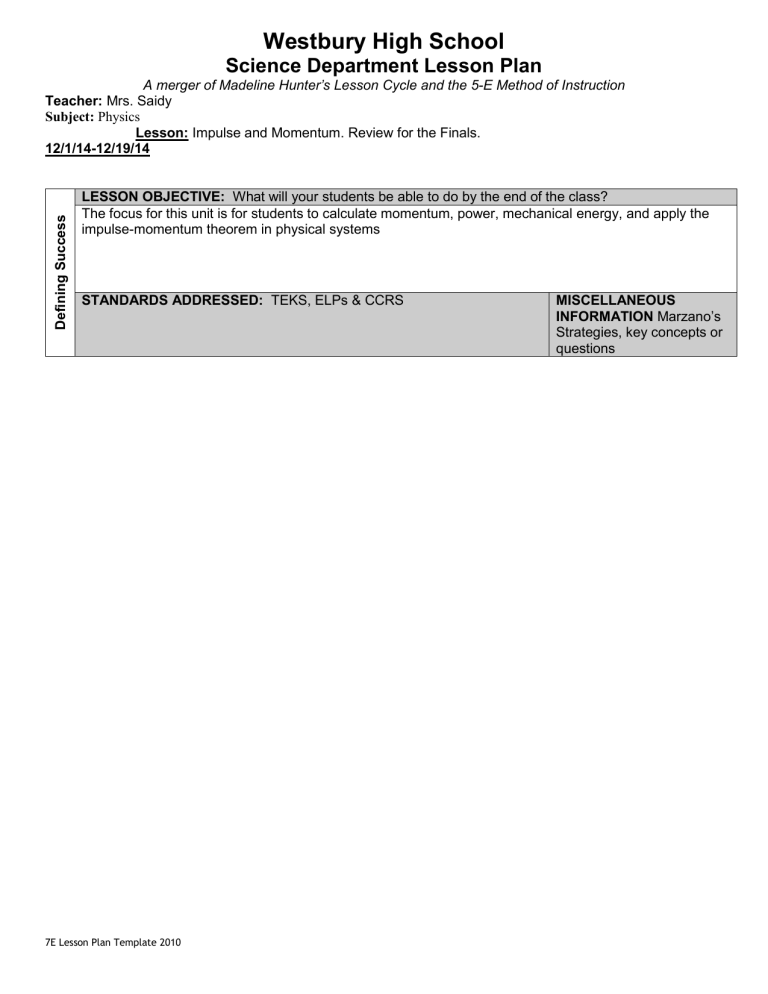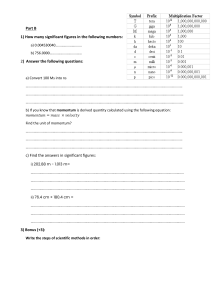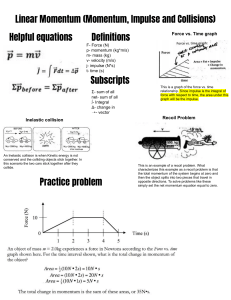
Westbury High School Science Department Lesson Plan Defining Success A merger of Madeline Hunter’s Lesson Cycle and the 5-E Method of Instruction Teacher: Mrs. Saidy Subject: Physics Lesson: Impulse and Momentum. Review for the Finals. 12/1/14-12/19/14 Free Body Di LESSON OBJECTIVE: What will your students be able to do by the end of the class? The focus for this unit is for students to calculate momentum, power, mechanical energy, and apply the impulse-momentum theorem in physical systems STANDARDS ADDRESSED: TEKS, ELPs & CCRS 7E Lesson Plan Template 2010 MISCELLANEOUS INFORMATION Marzano’s Strategies, key concepts or questions Compare and Contrast Summarize and NoteTaking • PHYS.2E Design and implement investigative procedures including making observations, asking well-defined questions, formulating testable hypotheses, identifying variables, selecting appropriate equipment and technology, and evaluating numerical answers for reasonableness. • PHYS.2H Make measurements with accuracy and precision and record data using scientific notation and International System (SI) units. • PHYS.2J Organize and evaluate data and make inferences from data including the use of tables, charts, and graphs. • PHYS.2K Communicate valid conclusions supported by the data through various methods such as lab reports, labeled drawings, graphic organizers, journals, summaries, oral reports, and technology-based reports. • PHYS.2L Express and manipulate relationships among physical variables quantitatively including the use of graphs, charts, and equations. • PHYS.3E Research and describe the connections between physics and future careers. • Ⓡ PHYS.6C Calculate the mechanical energy of, power generated within, impulse applied to, and momentum of a physical system. 7E Lesson Plan Template 2010 Nonlinguistic Representations Cooperative Learning Why is safety important during a laboratory investigation? Why is safety in the science classroom a number one priority for teachers, students, and parents? How do we investigate/understand and communicate the study of natural phenomena? ELPS.C.1.b Monitor oral and written language production and employ self-corrective techniques or other resources. ELPS.C.2.b Recognize elements of the English sound system in newly acquired vocabulary such as long and short vowels, silent letters, and consonant clusters. ELPS.C.3.b Expand and internalize initial English vocabulary by learning and using high-frequency English words necessary for identifying and describing people, places, and objects, by retelling simple stories and basic information represented or supported by pictures, and by learning and using routine language needed for classroom communication. ELPS C.1.d Speak using learning strategies such as requesting assistance, employing non-verbal cues, and using synonyms and circumlocution (conveying ideas by defining or describing when exact English word are not known). ELPS C.2.a Distinguish sounds and intonation patterns of English with increasing ease. ELPS C.3.a Practice producing sounds of newly acquired vocabulary such as long and short vowels, silent letters, and consonant clusters to pronounce English words in a manner that is increasingly comprehensible. ELPS C.1.f Use accessible language and learn new and essential language in the process. ELPS C.2.c Learn new language structures, expressions, and basic and academic vocabulary heard during classroom instruction and interactions. ELPS C.3.c Speak using a variety of grammatical structures, sentence lengths, sentence types, and connecting words with increasing accuracy and ease as more English is learned. CCRS VIII.C.1 Understand the fundamental concepts of kinematics. CCRS VIII.C.2 Understand forces and Newton’s Laws CCRS VIII.A. Understand Concurrent and Resultant Forces. Less on Cycl e ANTICIPATORY SET: (ENGAGE): A “hook” to get the students interest and attention. (A question, picture, 2-3 minute long video clip, a demonstration). 7E Lesson Plan Template 2010 MATERIALS M: Do Now connected to Homework with debrief – Check for understanding ( Circular motion ) W: Do Now connected to Homework with debrief – Check for understanding (Impulse ) F: Do Now (Projectile Motion). T: Do Now (Momentum) Th: Do Now (conservation of momentum) M: Do Now Review for Finals W-F: Finals. TEACHING/INSTRUCTIONAL PROCESS: (EXPLORE/EXPLAIN): Provide students with a common experience (Labs, hands on activities). Debrief activity, teach concept. M: Open Discussion – Impulse and Momentum – Collaborative and Small Group Activity. Watch video generate high order thinking. Calculate the Impulse and momentum of certain objects. . Collaborative and Small Group Activity W: Describe and Calculate the force and the time needed to change the momentum of certain objects. Collaborative and Small Group Activity F: Calculate the momentum and Impulse of different objects. . Collaborative and Small Group Activity T: Lab activities on momentum and Impulse. Collaborative and Small Group Activity. Th: Review for the finals Collaborative and Small Group Activity M: Review for the finals. W-F Finals 7E Lesson Plan Template 2010 Lab Safety Contracts Notebook paper Worksheets Graph Paper GUIDED PRACTICE AND MONITORING: (EXPLAIN). Interactive discussions between teacher and students. Guide/help students as they solve problems and/or answer questions. Clarify misconceptions and check for understanding. M: Taking notes and watching video and demonstrations on Impulse and Momentum. W: Calculate Impulse and Momentum group and individual work. F: Interactive discussion and problem solving on Impulse and Momentum. T: Interactive demonstration and discussion on Conservation of Momentum. Th: Explain Mathematical relationship and model of force and time, velocity and distance, mass and momentum. Teacher-lead whole group activity M: Review for finals W-F Finals. INDEPENDENT PRACTICE: (ELABORATE) Students apply the information learned in the Explain to answer questions or solve problems. M: Calculate force and time to measure the impulse and the momentum. (Repeat activity to clarify misunderstanding) Student Problem Set. W: Calculate momentum, impulse, force, and time using work sheet. F: Work sheet on Impulse and Momentum. T: Set of problems on Conservation of Momentum Th: Work sheet on Review for Finals. M Review for finals W-F Finals 7E Lesson Plan Template 2010 EVALUATE: Assess student mastery. (Quizzes, Lab Reports, Unit tests) M: Impulse. Student Problem Set - Share and Debrief Solutions Individual and Small Group Presentations W: Momentum-(Student problem set) - Individual and Small Group Presentations F: Impulse and Momentum problems worksheet. T: Conservation of Momentum Individual and small group activity. Th: Review for finals problems worksheet. M: Review for Finals W-F: Finals 7E Lesson Plan Template 2010


